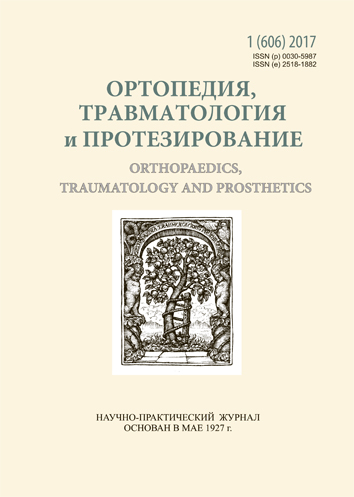Estimation of the primary stability of the press-fit and screwed-in acetabular components after hip joint arthroplasty
DOI:
https://doi.org/10.15674/0030-59872017192-97Keywords:
hip joint, arthroplasty, acetabular component, finite element method, stress-strain stateAbstract
Arthroplasty is one of the most common and effective treatments for degenerative diseases and injuries of the hip joint, but marked increase in the number of revision procedures associated with instability of the implant, including cups, and a pair of friction problems.
Objective: using biomechanical methods to evaluate the primary acetabular stability with screwing up and press-fit components.
Methods: to evaluate the stress-strain state and subchondral spongy tissues in the acetabular zone under load of 1000 H, developed a simplified design scheme of the hip joint and healthy model of «bone – cup – insert – head» implant using finite element method. Press-fit and that screwing up cups were studied.
Results: in healthy hip joint any stress concentrators are absent. Maximum values are 0.09 MPa stress-strain state on the strength of spongy bone tissue 12.17 MPa. The most strenous share of subchondral bone is part of the roof — 16.24 MPa for her strength of 150–200 MPa. If using press-fit cups revealed increasing tension of spongy tissue in 4 ÷ 5 times, and at the entrance to the subchondral acetabular zone — 2 ÷ 3 times. With the use of screw up cups t transferring the load on the pelvic bone closest to the healthy joint. Small local stress concentrators in the spongy tissue occur in the contact zone of the threaded subchondral and spongy tissue and at a distance of 1mm their value is reduced by 2–3 times and does not exceed 0.3 MPa.
Conclusions: the use of screw up cup has advantages, especially in osteoporosis, because after implantation load on the pelvic bone close to the stress-strain state of healthy hip joint.References
- Horst P, Sproul RC, Bozic KJ. The economics of total hip and knee arthroplasty. Techniques in revision hip and knee arthroplasty. Ed. By R. Scuderi. Philadelphia: Elsevier, 2015, рр. 2–5.
- Ahtiyamov IF. Kuzmin II. Oshibki i oslozhneniya endoprotezirovaniya tazobedrennogo sustava (Errors and complications of hip arthroplasty). Kazan: Tsentr operativnoy pechati, 2006. 328 p. (in Russian)
- Zagorodniy NV. Endoprotezirovaniye tazobedrennogo sustava. Osnovi i praktika: rukovodstvo (Endoprosthetics of the hip joint. Fundamentals and Practice: A Guide). Moskow: GEOTAR. Media, 2011. 704 p. (in Russian)
- Prokhorenko VM. Pervichnoe i revizionnoye endoprotezirovaniye tazobedrennogo sustava (Primary and revision arthroplasty of the hip joint). Novosibirsk: ANO «Klinika NIITO», 2007. 348 p. (in Russian)
- Sulyma OM. Reviiyne endoprotezuvannia pry aseptychniy nestabilnosti acetabuliarnoho komponenta endoproteza ta defektah kul’shovoi zapadyny (Revision endoprosthetics with aseptic instability of the acetabular component of the endoprosthesis and defects in the vertical cavity): abstract dissertation of the PhD in Traumatology and Prosthetics. Kyiv, 2011. 26 p. (in Ukrainian)
- Loskutov AE. Endoprotezirovaniye tazobedrennogo sustava: monographiya (The Hip Arthroplasty). Dnepropetrovsk: Lira, 2010. 344 p. (in Russian)
- Filippenko VA, Korzh NA. Endoprotezirovaniye tazobedrennogo sustava (The Hip Arthroplasty). Kharkiv: Kollegium, 2015. 219 p. (in Russian)
- Gunther KP, Al-Dabouby F, Bernstein P. How to do a cementless hip arthroplasty. Eur Instructional Lectures. 2009;9:189–202. doi: 10.1007/978-3-642-00966-2_19.
- Li H, Mao Y, Oni JK, Dai K, Zhu Z. Total hip replacement for developmental dysplasia of the hip with more than 30 % lateral uncoverage of uncemented acetabular components. Bone Joint J. 2013;95-B:1178–83. doi: 10.1302/0301-620X.95B9.31398.
- Vasu R, Carter J, Harris WH. Stress distributions in the acetabular region-1 before and after total joint replacement. J Biomechanics. 1982;15(3):155–64.
Downloads
How to Cite
Issue
Section
License
Copyright (c) 2017 Oleg Loskutov, Nadiia Naumenko, Oleksandr Loskutov, Dmytro Syniehubov, Dmytro Gorobets, Kseniya Furmanova

This work is licensed under a Creative Commons Attribution 4.0 International License.
The authors retain the right of authorship of their manuscript and pass the journal the right of the first publication of this article, which automatically become available from the date of publication under the terms of Creative Commons Attribution License, which allows others to freely distribute the published manuscript with mandatory linking to authors of the original research and the first publication of this one in this journal.
Authors have the right to enter into a separate supplemental agreement on the additional non-exclusive distribution of manuscript in the form in which it was published by the journal (i.e. to put work in electronic storage of an institution or publish as a part of the book) while maintaining the reference to the first publication of the manuscript in this journal.
The editorial policy of the journal allows authors and encourages manuscript accommodation online (i.e. in storage of an institution or on the personal websites) as before submission of the manuscript to the editorial office, and during its editorial processing because it contributes to productive scientific discussion and positively affects the efficiency and dynamics of the published manuscript citation (see The Effect of Open Access).














